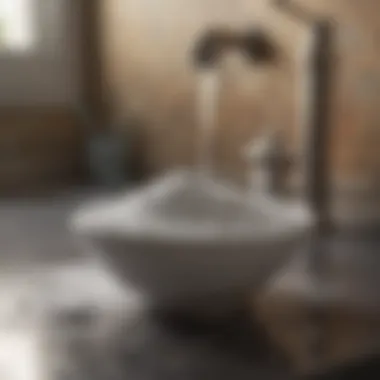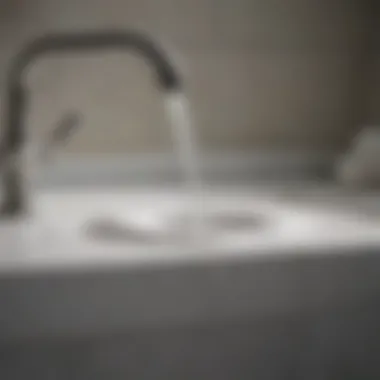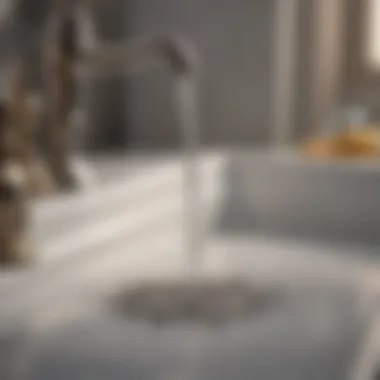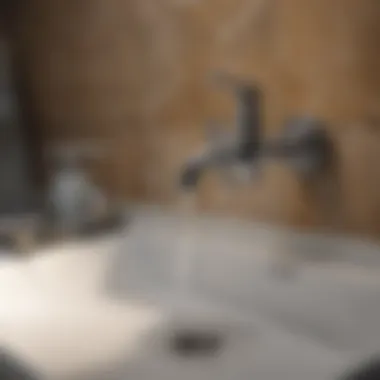Effective Techniques to Clean Bathroom Sink Drains


Intro
Cleaning bathroom sink drains can feel like an endless chore for many homeowners. Over time, clogs build up from soap scum, hair, and other debris, leaving sinks slow to empty or even completely blocked. Rather than reaching for harsh chemicals that can not only damage your plumbing but are also toxic, consider the simple yet powerful cleaning agent that is baking soda. This natural substance can be an effective solution for maintaining your drains while promoting a cleaner home environment.
Baking soda works wonders by reacting with acidic substances, producing carbon dioxide that helps to dislodge gunk and grime. It's not just plain good for draining; the process is quite fascinating when you look closely at the science behind it. In this article, we’ll dive into efficient techniques for employing baking soda as your go-to cleaning method for bathroom sinks. From practical tips to periodic maintenance, you will gain insights that will keep your drains flowing smoothly for the long haul.
In exploring these techniques, you'll learn to leverage both preventive measures and maintenance strategies that complement the cleaning process. So, whether you’re tackling a stubborn clog or looking to maintain optimal drainage, these insights will be invaluable. Let's get started on ensuring your sinks remain free-flowing, pristine, and as effective as they should be.
Prologue to Drain Maintenance
Maintaining the cleanliness and functionality of bathroom sink drains is often overlooked, but it plays a critical role in home hygiene and aesthetics. When drains are left unchecked, they can become a breeding ground for unwanted odors and harmful bacteria. Regular drain maintenance not only ensures optimal water flow but also prolongs the lifespan of plumbing systems.
Understanding the nuances of drain maintenance can save homeowners time, effort, and money. It's not merely about clearing out occasional clogs; it involves establishing a routine that anticipates issues before they arise. By integrating simple techniques like using baking soda, you can keep your drains in tip-top shape without resorting to harsh chemicals that might damage the plumbing.
Both convenience and cost-effectiveness favor DIY methods for drain cleaning. Plus, the satisfaction derived from using a common household item like baking soda cannot be understated. Below, we will dive deeper into the specific components of bathroom sink drains and explore the common issues they encounter, providing a roadmap for effective maintenance strategies.
Understanding Bathroom Sink Drains
Bathroom sink drains consist of an assembly of components designed to efficiently pull water away while preventing backflow. The key parts include the drain pipe, trap, and vent. Each of these elements performs a crucial role:
- Drain Pipe: The main conduit that leads wastewater away from the sink to the home's sewer or septic system.
- Trap: A curved section of the plumbing that holds water. This water creates a seal, preventing sewer gases from entering the bathroom.
- Vent: Essential for allowing air to enter the plumbing system, which helps maintain proper pressure and encourages the smooth flow of water and waste.
Over time, various substances can accumulate in the drain, such as hair, soap residue, and other debris. Understanding how your drains work can empower you to maintain them effectively, reducing the likelihood of obstructions.
Common Drain Issues
Just like that neighbor who never seems to clean their yard, drains can fall victim to neglect. Here are some of the most common issues people encounter with bathroom sink drains:
- Clogs: Accumulation of hair, soap, toothpaste, and even bits of food can create significant blockages. Clogs often lead to slow drainage and unpleasant odors.
- Odors: Stagnant water combined with organic matter can produce foul smells, making your bathroom less welcoming.
- Leaks: A leaking drain, while often less common, can result from corroded pipes or worn seals, leading to water damage in the surrounding area.
Recognizing these issues early on is key to preventing larger plumbing problems. By staying informed and proactive about your bathroom sink drain maintenance, you can save yourself from the hassle and expense of more serious repairs down the line.
The Role of Baking Soda
Baking soda is often found in most kitchens, but its role transcends mere baking. In this article, we dive into the usefulness of baking soda, particularly focusing on maintaining our bathroom sink drains. As a natural cleaning agent, it shines due to its simplicity and effectiveness.
Understanding the role of baking soda becomes essential when considering how to tackle drainage issues without resorting to harsh chemicals. It's not just about cleaning; it’s about sustaining cleanliness in a manner that’s gentler on both our environment and our plumbing systems.
Unlike some aggressive cleaning agents that could potentially harm pipes or irritate skin, baking soda can be both benign and particularly handy. As we unpack its chemical properties and the myriad benefits it offers, we’ll highlight why this versatile substance is a go-to choice for many homeowners.
Chemical Properties of Baking Soda
Baking soda, or sodium bicarbonate, is interesting from a chemical perspective. When looking at its composition, we find that each molecule consists of sodium, hydrogen, carbon, and oxygen. This unique assembly results in a compound that is mildly alkaline. Its alkaline nature allows it to neutralize acids, making it particularly useful when dealing with stubborn clogs caused by greasy residues and soap scum.
When baking soda interacts with acids, it triggers a reaction that produces carbon dioxide gas. This fizzy response is what makes it so effective in cleaning. In practical terms, when we pour baking soda down our sink followed by some vinegar, the reaction helps to break down grime and debris that may be clinging to the sides of the pipes.


Benefits of Using Baking Soda
Using baking soda to promote clear, clean bathroom sink drains brings forth numerous benefits:
- Eco-Friendly: It’s a sustainable option that doesn’t contribute to pollution.
- Cost-Effective: Often available at a lower price compared to commercial cleaners, it packs a punch without emptying your wallet.
- Versatile Uses: Beyond drains, it's effective in deodorizing fridges, freshening carpets, and cleaning various surfaces.
- Gentle on Surfaces: Unlike abrasive cleaners, baking soda won’t scratch or damage your sink’s surfaces.
Most importantly, incorporating baking soda into your regular cleaning routine promotes cleaner and safer household environments we can all appreciate. When you’re looking to clear the muck without the muck, it’s time to welcome baking soda into your home care arsenal.
Preparing for Cleaning
Cleaning a bathroom sink drain may not sound like the most glamorous of tasks, but preparing for the cleaning is paramount for a seamless process and effective results. Taking the time to gather the right tools and materials not only saves you from scrambling around halfway through but also sets the stage for a more efficient and satisfying cleanup. If you’re understandably eager to get this chore off your plate, giving it a bit of thought now will pay dividends later.
When preparing for cleaning, consider the specific elements needed. One of the primary benefits of this phase is that it ensures you have everything at hand. Having an organized workspace can significantly enhance productivity. A chaotic environment can lead to distractions, which might result in missing steps during the cleaning process or failing to achieve the desired results.
In addition, gathering your materials allows you to familiarize yourself with each tool’s purpose. Understanding how each element contributes to the cleaning process will empower you to use them more effectively. A little prep work makes a big difference down the line.
Required Tools and Materials
To embark on a successful drain cleaning mission, you ought to have a few essential items ready to go. This includes:
- Baking Soda: Your secret weapon against grime.
- Vinegar: The trusty partner that boosts the cleaning effectiveness of baking soda.
- Boiling Water: A must-have for flushing the drain and ensuring a thorough rinse.
- Rubber Gloves: Protects your hands from gunky residues.
- Old Toothbrush: Great for scrubbing those hard-to-reach areas.
- Drain Plunger: Just in case you encounter stubborn clogs.
By assembling these materials, you’ll create a mini arsenal against the clogs and odors that tire us all from time to time.
Safety Precautions
Before you dive into the nitty-gritty of the cleaning process, safety should be front and center in your mind. It’s easy to overlook this crucial aspect when getting caught up in the task at hand, but a little caution goes a long way.
Firstly, always wear rubber gloves. Not only do they shield your hands from grease and old food remnants, but they also protect you from harsh substances that may linger in the drain. Being cautious about your skin contact can prevent unintended irritation.
Ensure that the area is well-ventilated, especially if you’re using powerful cleaning agents alongside baking soda and vinegar. While these natural options are less hazardous, if you employ other chemicals, proper ventilation is crucial to avoid inhaling unwanted fumes.
Finally, keep all tools within easy reach but out of the way to prevent accidents. For instance, you don’t want to slip on a plunger handle or knock over a bottle of vinegar while focused on the task.
"A little preparation can keep a mundane task from turning into a messy disaster. Staying organized not only aids efficiency but enhances effectiveness."
Making a checklist of tools and safety measures can be a useful step to ensure you have everything under control before diving in. Taking these precautions allows you to focus on the task and helps ensure a smooth cleaning process.
Step-by-Step Cleaning Process
Cleaning bathroom sink drains can often feel like one of those jobs that you’d rather put off until another day. However, it’s a necessary task for maintaining a clean and functional bathroom. The step-by-step cleaning process ensures that you tackle this chore effectively and efficiently. Knowing how to clean your sink drain not only aids in keeping your home fresher but also prevents blockages and slow drainage issues.
Initial Inspection of the Drain
Before diving into the cleaning, a quick inspection of the drain is crucial. Look for any visible buildup, hair clogs, or other debris that might have accumulated over time. A keen eye during this phase can save frustration later. Often, just shining a flashlight into the drain can reveal not just the size of the problem but also the best approach to take.


Checking the condition of the surrounding plumbing is also wise. Look for leaks or signs of corrosion. If you happen to spot anything unusual, a professional might be needed down the line, depending on the severity.
Applying the Baking Soda
Once the inspection is done, it’s time to use the baking soda. Pour about half a cup of baking soda directly into the drain. This ingredient acts as a gentle abrasive and helps to dislodge any stubborn debris. It’s essential to make sure that the baking soda gets to the problem area and not just sit on top of any greasy residue.
Tip: For those extra stubborn clogs, you might want to let the baking soda sit for a while before proceeding to the next step. Allowing it to dwell for about 15-20 minutes can enhance its cleaning properties, giving it a chance to work its magic on the grime.
Adding Vinegar for Enhanced Cleaning
Next comes the magic ingredient—vinegar. After letting the baking soda sit, pour about a cup of white vinegar down the drain. The reaction between the baking soda and vinegar creates bubbles, similar to a mini-volcano effect. This fizzing not just looks fun but also indicates that dirt and debris are being broken apart.
Be sure to cover the drain with a cloth or plug to keep the reaction happening within the pipes. However, you can also skip this step if you want the reaction to echo a bit, as it might help dislodge debris. Just remember, this type of cleaning can get a little messy.
Rinsing the Drain
Once the fizzing has stopped—often after a few minutes—it’s time to rinse. Run hot water through the drain for a few minutes, allowing any dislodged debris to wash away. This step is vital. If you don’t rinse everything thoroughly, the pieces might just settle further down in the pipes. It's like washing away the remnants of a good meal; you wouldn't want to leave crumbs stuck, now would you?
Use about two quarts of hot water to ensure a complete rinse. After this step, you should notice a significant difference in the flow of water down the drain. If the drain remains slow, a second round of baking soda and vinegar might be necessary, or it could indicate a more significant blockage that requires a plumber's help.
"Regularly maintaining your bathroom sink drains can prevent future headaches and costly repairs. "
By following these steps, you ensure a cleaner, healthier bathroom with minimal effort. Regular maintenance can go a long way in keeping your home in tip-top shape.
Post-Cleaning Maintenance
After you've put in the elbow grease to clean your bathroom sink drain using baking soda, the job isn’t quite finished. Just like a car that needs regular oil changes, your sink also requires continued upkeep. Post-cleaning maintenance ensures that your efforts yield long-lasting results. When drains are neglected, issues can creep back, leading to clogs and unpleasant odors.
The importance of this stage centers around a couple of key elements:
- Prevent Reoccurrence of Clogs: By routinely inspecting and maintaining your sink’s drainage system, you can catch potential blockages before they worsen. This might mean a simple flush of hot water once a week or using a strainer to catch hair and debris.
- Preserve Plumbing Health: Regular maintenance contributes to the longevity of your plumbing. When drains stay clean, there’s less stress on the pipes, which can help prevent leaks and corrosion over time.
Regular Inspection Tips
Staying proactive can make a world of difference. Here are some effective strategies for regular inspections:
- Visual Check: Take a moment to glance under your sink monthly. Look for any signs of leaks or dampness around the pipes.
- Sniff Test: Sounds odd, but give a sniff near the drains. Any off-putting odors might indicate something darker lurking in the system.
- Water Flow Test: Run water down the drain for a minute and then see how quickly it flows away. If it seems sluggish, that’s a signal to act before things worsen.
- Occasional Deep Clean: Schedule a deep-cleaning session every couple of months. Combine baking soda and vinegar to keep the drains in tip-top shape.
When to Use Professional Services
Despite your best efforts at maintenance, some situations demand the expertise of professionals. Here’s when it might be time to call in the experts:
- Persistent Odors: If strange smells persist despite your cleaning efforts, consider that there may be an underlying issue needing specialized inspection.
- Frequent Clogs: When clogs happen often, it might indicate a bigger problem, such as tree roots infiltrating pipes or significant buildup.
- Water Backup: If water starts backing up into the sink, don’t wait. This can point towards severe clogs or issues within the main sewer line.
Professional services can save you money in the long run by addressing issues before they escalate into costly repairs.


In summary, while cleaning with baking soda is a fantastic natural approach, post-cleaning maintenance plays a pivotal role in maintaining your bathroom sink’s health. Regular checks can save headaches down the line, and knowing when to escalate to a professional service is just as important. Maintain the rhythm of care, and your bathroom will remain a serene oasis, free from messy disruptions.
Preventive Measures
Preventive measures play a vital role in maintaining the efficiency of bathroom sink drains and significantly reduce the frequency of cleaning required. The age-old adage, "an ounce of prevention is worth a pound of cure," truly applies here. A little foresight can save a homeowner from a lot of hassle down the line.
Regularly engaging in routine maintenance not only keeps your drains flowing freely but also keeps unpleasant odors at bay. These practices can extend the life of your plumbing system by preventing the buildup of gunk and debris that often leads to blockages. Moreover, taking simple steps to protect your drain may often eliminate the need for heavier cleaning, like the intensive baking soda treatment.
Routine Maintenance Practices
Keeping your bathroom sink drains clean doesn't have to require much effort if you incorporate a few sound practices into your regular cleaning routine:
- Flush with Water: Simply running a hot water flush down your sink on a weekly basis can help prevent grease and soap scum from hardening and causing a blockage.
- Baking Soda and Vinegar Routine: Doing a bi-monthly treatment with baking soda followed by vinegar helps to clear out minor clogs before they become serious. This should only take a few minutes but can greatly reduce maintenance hassle.
- Loosen Debris: Use a long, flexible brush or even an old toothbrush to reach into your sink drain and dislodge any visible debris that has accumulated near the drain entry. This keeps the pathway clear from buildup.
By integrating these seemingly straightforward steps into your cleaning repertoire, you'll likely find the overall health of your drains improving dramatically.
Choosing Appropriate Drain Covers
An often-overlooked tool in drain maintenance is the use of drain covers. Adding these covers can be a wise move to avoid many common plumbing issues. It’s about catching things before they enter the drain in the first place.
- Type of Cover: Choose a cover that has small openings designed to catch hair and larger particles without blocking water flow. Strainers work great for this, efficiently keeping debris from entering your pipes.
- Easy to Clean: Drain covers with smooth surfaces are ideal, as they are easy to rinse off and keep clean. Separate pieces that allow for easy lifting can make regular maintenance simple.
- Secured Fit: Make sure your drain cover fits snugly to avoid any accidental displacements. The last thing you want is for it to shift under pressure and allow a buildup of hair and soap scum.
Tip: Some covers are designed to act as a decorative addition to your sink. This way, function meets style.
Choosing the right cover can make all the difference, both aesthetically and practically. Maintaining your bathroom sink drain doesn’t have to be a strenuous chore—it's about laying the groundwork for a cleaner, healthier environment.
End
Cleaning bathroom sink drains with baking soda is more than a mere chore; it’s a vital practice to uphold hygiene and prevent unpleasant odors in our living spaces. As we’ve seen, the effectiveness of benevolent baking soda goes hand in hand with its eco-friendliness, making it an ideal solution for household maintenance. By understanding how to harness the properties of this humble ingredient, homeowners can save both money and effort when it comes to keeping their drains running freely.
Summarizing the Effectiveness of Baking Soda
Baking soda acts as a mild abrasive and a base, which means it can scuff away grime and neutralize acidic odors without being overly harsh on plumbing. When combined with vinegar, this dynamic duo produces a fizzing action — a visual spectacle that reflects the chemical reaction taking place. This bubbling motion effectively clears clogs, as it helps to dislodge debris and disintegrate greasy buildups that are often present in bathroom sink drains.
Here are key points on baking soda’s effectiveness:
- Cost-Effective: Compared to chemical cleaners, baking soda is quite affordable.
- Environmentally Friendly: No harsh chemicals involved, making it safe for septic systems.
- Non-Toxic: Safe around children and pets.
- Easy Availability: Most households already have this staple on hand.
Thus, understanding these points justifies why it should be a go-to option for many households.
Encouraging Regular Maintenance Habits
Fostering a habit of regular maintenance can extend the lifespan of your bathroom fixtures and prevent major plumbing woes. Instead of waiting for visible clogs, consider a proactive approach. Integrating simple techniques within your cleaning routine is paramount. Here are some habits to adopt:
- Monthly Cleaning: Set aside time once a month for a thorough clean of drains. A good reminder might be the start of each new month.
- Watch What Goes Down: Avoid letting hair, food scraps, or greasy residues slip into the sink. Using a fine mesh strainer can assist in this regard.
- Employ a Weekly Flush: Once a week, flush your drains with hot water mixed with baking soda. This can help keep everything flowing smoothly and prevent build-up.
By turning these practices into ritual, you'll inevitably enhance drain effectiveness while sidestepping unpleasant surprises. Such habits not only maximize cleanliness but will also contribute greatly to the overall system efficiency.
"An ounce of prevention is worth a pound of cure." - Benjamin Franklin
In the end, embracing the simplicity of these maintenance techniques can make the daunting task of drain cleaning much more manageable, leading to a healthier and happier home.















